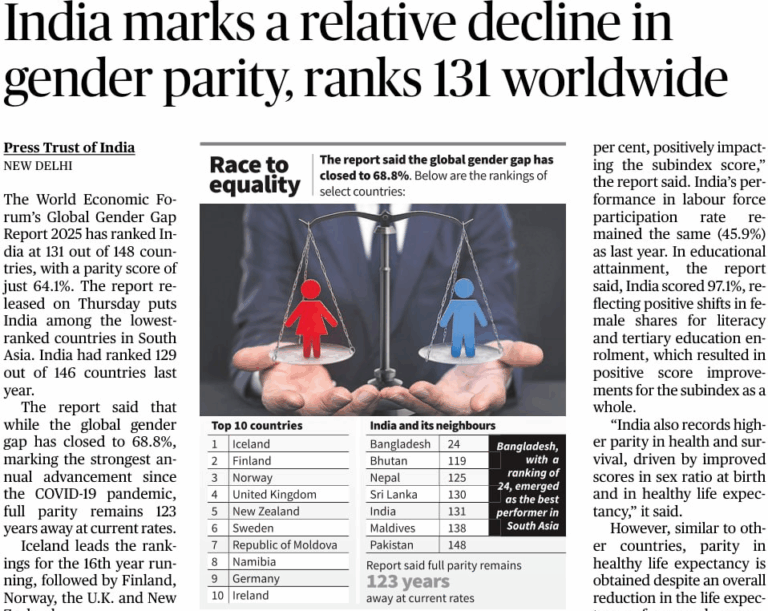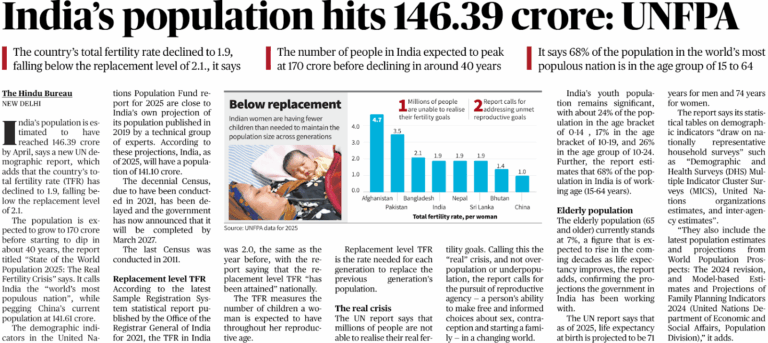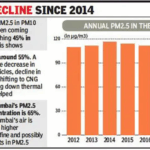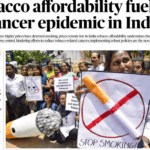Violent Crimes by Juveniles in India: Causes, Trends & Legal Response
Why in the news?
June 12 symbolises the World Day against Child Labour(WDACL), highlighting children’s rights and weaknesses. Nevertheless, another dangerous question involving children – the emergence of violent crimes committed by young girls – has begun to make headlines in India.
- Recent data from the National Crime Records Bureau (NCRB) suggests that about half of all teens arrested in India in 2022 (49.5%) were involved in violent crimes; there was a faster increase in 32.5% 2016.
Background: Juvenile Crime and Legal Architecture in India
Defining Juvenile Justice
In India, individuals under the age of 18 who commit a crime fall under the juvenile justice system, governed by the Juvenile Justice (Care and Protection of Children) Act, 2015.
The Act aims to balance two objectives:
- Ensuring rehabilitation and reintegration of children in conflict with the law.
- Recognising the gravity of heinous crimes, especially by children aged 16–18.
The Act allows for juveniles aged 16–18 to be tried as adults for heinous offences (e.g., rape, murder), but only after a preliminary assessment by the Juvenile Justice Board (JJB).
Rising Concerns Globally
- Across countries like the UK and the US, there has been a rise in adolescent-perpetrated violent crimes, often involving knives, sexual violence, and group assaults.
- While juvenile crime overall may be falling due to demographic and technological shifts, the proportion of violent crimes is steadily increasing.
Features: The Emerging Pattern in India
Statistical Evidence of the Surge
- Rising Share of Violent Offences: NCRB data shows that while the absolute number of juveniles in conflict with the law declined from 37,402 in 2017 to 33,261 in 2022, the share involved in violent crimes rose from 32.5% in 2016 to 49.5% in 2022.
- Types of Violent Crimes: These include rape, sexual assault, murder, grievous hurt, robbery, and dacoity. Minor offences like theft and pickpocketing are not included in this category.
- Hubli (2024): A 13-year-old stabbed a friend over an argument related to snacks.
- Chennai (2024): 7 minors among 12 accused of raping a 13-year-old girl.
These incidents point to a worrying normalisation of extreme aggression among adolescents.

State-wise Disparities
High-Contribution States (2017–2022):
- Madhya Pradesh: 20% of all juvenile violent crimes
- Maharashtra: 18%
- Rajasthan: 9.6%
- Chhattisgarh: 8.4%
- Tamil Nadu: 5%
Despite its small size, Delhi accounted for 6.8%- possibly due to improved reporting mechanisms and awareness.
Highest Proportion of Violent Juvenile Offences Within States:
- Jharkhand: 67% of juvenile crimes were violent
- Tripura, West Bengal, Chhattisgarh, Madhya Pradesh: Over 60% violent
These trends suggest that central and eastern Indian states are emerging as hotspots for violent juvenile crimes.

Profile of Juvenile Offenders
- Age: The Majority fall in the 16–18 age group, the transitional phase to adulthood.
- Gender: Over 90% are male, reflecting gendered expressions of aggression.
- Socioeconomic Background: Predominantly from poor, low-literacy, and broken family structures.
- Education: Many are school dropouts, or irregular in attendance.
- Repeat Offenders: A rising number are repeat offenders, showing gaps in reformative intervention.
Challenges
Legal and Procedural Limitations
- Discretionary Trials as Adults: Under the JJ Act 2015, a juvenile aged 16–18 may be tried as an adult only after an assessment by the JJB, which lacks clear guidelines, leading to inconsistencies.
- Lack of Rehabilitation Infrastructure: Observation homes and special homes are overcrowded and underfunded, lacking professional psychological and educational support.
- Underreporting and Inconsistent Data: Many cases are not registered due to stigma, family reluctance, or police apathy. There is also no disaggregated data on motivations, social triggers, or post-rehabilitation outcomes.
Societal and Psychological Factors
- Exposure to Online Violence: Easy access to violent games, misogynistic content, and cyberbullying has created a hyper-masculine, aggressive adolescent culture.
- Incel and Extremist Subcultures: Emerging online communities like incels (involuntary celibates) foster misogyny and encourage violent fantasies.
- Neglect and Abuse: Many juvenile offenders come from homes with domestic violence, alcoholism, or child abuse, creating a cycle of trauma.
- Peer Pressure and Gang Culture: Adolescents in urban slums often join gangs as a form of identity and belonging.
Systemic and Structural Challenges
- Urbanisation without Inclusion: Rapid urbanisation has created informal settlements where basic education and family welfare are missing.
- Education Deficit: Many adolescents either drop out or are unable to relate to the rigid schooling system.
- Unemployment and Idleness: With no meaningful engagements, juveniles often turn to crime out of boredom or desperation.
- Delayed Justice: Slow judicial processes fail to instil a sense of accountability or reformation in time.
Way Forward
Reimagining Juvenile Justice Reform
- Strengthen Juvenile Justice Boards: Provide them with trained psychologists, criminologists, and child protection officers to ensure nuanced assessments.
- Improve Correctional Infrastructure: Observation and special homes must become rehabilitation centres, not just custodial spaces. Invest in counselling, education, and skill-building.
- Fast-Track Hearings: For heinous crimes, ensure time-bound trials and decisions on trying as adults to maintain credibility and deterrence.
Social and Educational Interventions
- Early Warning System: Schools and Anganwadi centres must be trained to identify at-risk youth through changes in behaviour, absenteeism, or aggression.
- Digital Literacy and Online Safety: Include modules in school curricula to counter cyberbullying, online grooming, and incel ideologies.
- Gender Sensitisation: Launch targeted campaigns and peer mentorship programmes to dismantle toxic masculinity narratives.
- Alternative Education: Create non-formal, vocational, and arts-based education options for students unable to cope with traditional academic systems.
Community-Centric Approaches
- Engage Families: Counselling parents and building local support systems can reduce neglect and abuse at home.
- Local Mentorship Networks: Use NGOs and youth leaders to mentor and channel adolescent energy into sports, arts, or community projects.
- Youth Clubs and Safe Spaces: Establish recreational hubs in urban slums and rural belts where youth can engage positively.
Governance and Policy Framework
- Integrated Child Protection System (ICPS): Must be strengthened at the district level with better funding and inter-departmental coordination.
- Data Collection and Monitoring: Use tech-based dashboards to track juvenile crime trends in real-time, map hotspots, and trigger local responses.
- Policy Review: Consider a national review of the JJ Act, especially in terms of trial procedures, rehabilitation timelines, and post-rehabilitation monitoring.
Conclusion
The rising graph of violent crimes committed by juveniles in India is a reflection of deeper structural, social, and psychological challenges that adolescents are facing today. From online toxicity to family neglect, from broken education systems to peer radicalisation, the risk factors are manifold. While the current juvenile justice framework provides a constitutional and rights-based approach, the real transformation lies in making juvenile justice both preventive and rehabilitative. As India gears up to become a young superpower, ignoring the psycho-social needs and behavioural trends of its adolescent population will only deepen the crisis.
1. Why are violent crimes by juveniles increasing in India?
The increase is driven by multiple factors—cyber exposure, social alienation, school dropout, family neglect, and online subcultures like incel groups. Peer pressure and lack of structured recreation or guidance also contribute to this surge.
2. What constitutes a violent crime under juvenile offences?
Violent crimes include rape, murder, grievous hurt, attempted murder, robbery, dacoity, and arson. Non-violent crimes like theft or forgery are excluded in this context.
3. Which states are most affected by violent juvenile crimes?
According to NCRB data (2017-2022), Madhya Pradesh and Maharashtra account for nearly 40% of all such cases. In terms of proportion, Jharkhand, Tripura, and West Bengal report the highest share of violent crimes among all juvenile crimes.
MAINS PRACTICE QUESTION
Question: “What are the underlying causes behind the increasing incidence of violent crimes committed by juveniles in India, and how can policy, legal, and societal interventions work together to address this growing challenge?”
PRELIMS PRACTICE QUESTION
Q. Consider the following statements about the Juvenile Justice (Care and Protection of Children) Act, 2015:
Select the correct option:







